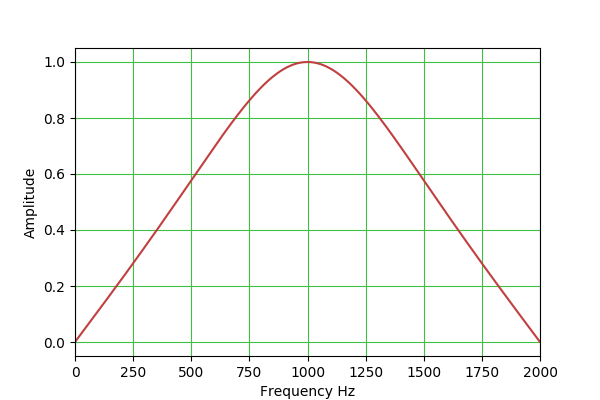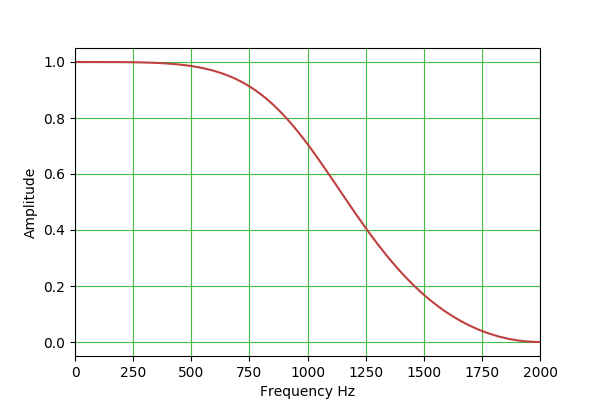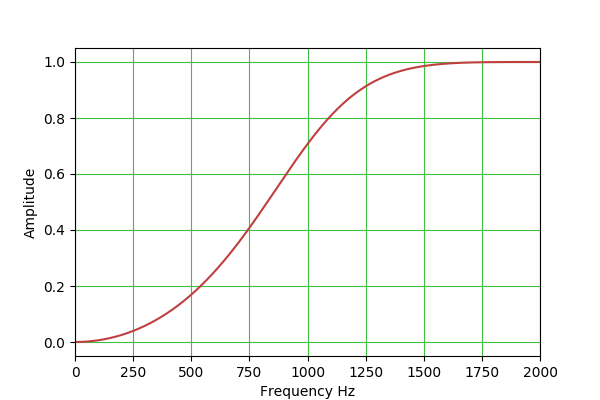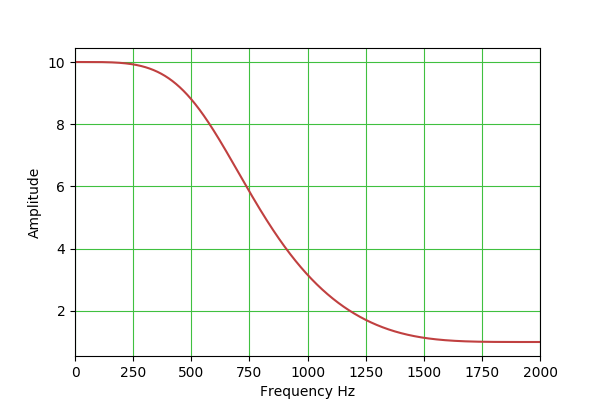转载:EQ--biquad filter
http://www.musicdsp.org/files/Audio-EQ-Cookbook.txt
https://arachnoid.com/BiQuadDesigner/index.html
https://blog.csdn.net/hunterhuang2013/article/details/64443718
Cookbook formulae for audio EQ biquad filter coefficients
----------------------------------------------------------------------------
by Robert Bristow-Johnson <rbj@audioimagination.com> All filter transfer functions were derived from analog prototypes (that
are shown below for each EQ filter type) and had been digitized using the
Bilinear Transform. BLT frequency warping has been taken into account for
both significant frequency relocation (this is the normal "prewarping" that
is necessary when using the BLT) and for bandwidth readjustment (since the
bandwidth is compressed when mapped from analog to digital using the BLT). First, given a biquad transfer function defined as: b0 + b1*z^-1 + b2*z^-2
H(z) = ------------------------ (Eq 1)
a0 + a1*z^-1 + a2*z^-2 This shows 6 coefficients instead of 5 so, depending on your architechture,
you will likely normalize a0 to be 1 and perhaps also b0 to 1 (and collect
that into an overall gain coefficient). Then your transfer function would
look like: (b0/a0) + (b1/a0)*z^-1 + (b2/a0)*z^-2
H(z) = --------------------------------------- (Eq 2)
1 + (a1/a0)*z^-1 + (a2/a0)*z^-2 or 1 + (b1/b0)*z^-1 + (b2/b0)*z^-2
H(z) = (b0/a0) * --------------------------------- (Eq 3)
1 + (a1/a0)*z^-1 + (a2/a0)*z^-2 The most straight forward implementation would be the "Direct Form 1"
(Eq 2): y[n] = (b0/a0)*x[n] + (b1/a0)*x[n-1] + (b2/a0)*x[n-2]
- (a1/a0)*y[n-1] - (a2/a0)*y[n-2] (Eq 4) This is probably both the best and the easiest method to implement in the
56K and other fixed-point or floating-point architechtures with a double
wide accumulator. Begin with these user defined parameters: Fs (the sampling frequency) f0 ("wherever it's happenin', man." Center Frequency or
Corner Frequency, or shelf midpoint frequency, depending
on which filter type. The "significant frequency".) dBgain (used only for peaking and shelving filters) Q (the EE kind of definition, except for peakingEQ in which A*Q is
the classic EE Q. That adjustment in definition was made so that
a boost of N dB followed by a cut of N dB for identical Q and
f0/Fs results in a precisely flat unity gain filter or "wire".) _or_ BW, the bandwidth in octaves (between -3 dB frequencies for BPF
and notch or between midpoint (dBgain/2) gain frequencies for
peaking EQ) _or_ S, a "shelf slope" parameter (for shelving EQ only). When S = 1,
the shelf slope is as steep as it can be and remain monotonically
increasing or decreasing gain with frequency. The shelf slope, in
dB/octave, remains proportional to S for all other values for a
fixed f0/Fs and dBgain. Then compute a few intermediate variables: A = sqrt( 10^(dBgain/20) )
= 10^(dBgain/40) (for peaking and shelving EQ filters only) w0 = 2*pi*f0/Fs cos(w0)
sin(w0) alpha = sin(w0)/(2*Q) (case: Q)
= sin(w0)*sinh( ln(2)/2 * BW * w0/sin(w0) ) (case: BW)
= sin(w0)/2 * sqrt( (A + 1/A)*(1/S - 1) + 2 ) (case: S) FYI: The relationship between bandwidth and Q is
1/Q = 2*sinh(ln(2)/2*BW*w0/sin(w0)) (digital filter w BLT)
or 1/Q = 2*sinh(ln(2)/2*BW) (analog filter prototype) The relationship between shelf slope and Q is
1/Q = sqrt((A + 1/A)*(1/S - 1) + 2) 2*sqrt(A)*alpha = sin(w0) * sqrt( (A^2 + 1)*(1/S - 1) + 2*A )
is a handy intermediate variable for shelving EQ filters. Finally, compute the coefficients for whichever filter type you want:
(The analog prototypes, H(s), are shown for each filter
type for normalized frequency.) LPF: H(s) = 1 / (s^2 + s/Q + 1) b0 = (1 - cos(w0))/2
b1 = 1 - cos(w0)
b2 = (1 - cos(w0))/2
a0 = 1 + alpha
a1 = -2*cos(w0)
a2 = 1 - alpha HPF: H(s) = s^2 / (s^2 + s/Q + 1) b0 = (1 + cos(w0))/2
b1 = -(1 + cos(w0))
b2 = (1 + cos(w0))/2
a0 = 1 + alpha
a1 = -2*cos(w0)
a2 = 1 - alpha BPF: H(s) = s / (s^2 + s/Q + 1) (constant skirt gain, peak gain = Q) b0 = sin(w0)/2 = Q*alpha
b1 = 0
b2 = -sin(w0)/2 = -Q*alpha
a0 = 1 + alpha
a1 = -2*cos(w0)
a2 = 1 - alpha BPF: H(s) = (s/Q) / (s^2 + s/Q + 1) (constant 0 dB peak gain) b0 = alpha
b1 = 0
b2 = -alpha
a0 = 1 + alpha
a1 = -2*cos(w0)
a2 = 1 - alpha notch: H(s) = (s^2 + 1) / (s^2 + s/Q + 1) b0 = 1
b1 = -2*cos(w0)
b2 = 1
a0 = 1 + alpha
a1 = -2*cos(w0)
a2 = 1 - alpha APF: H(s) = (s^2 - s/Q + 1) / (s^2 + s/Q + 1) b0 = 1 - alpha
b1 = -2*cos(w0)
b2 = 1 + alpha
a0 = 1 + alpha
a1 = -2*cos(w0)
a2 = 1 - alpha peakingEQ: H(s) = (s^2 + s*(A/Q) + 1) / (s^2 + s/(A*Q) + 1) b0 = 1 + alpha*A
b1 = -2*cos(w0)
b2 = 1 - alpha*A
a0 = 1 + alpha/A
a1 = -2*cos(w0)
a2 = 1 - alpha/A lowShelf: H(s) = A * (s^2 + (sqrt(A)/Q)*s + A)/(A*s^2 + (sqrt(A)/Q)*s + 1) b0 = A*( (A+1) - (A-1)*cos(w0) + 2*sqrt(A)*alpha )
b1 = 2*A*( (A-1) - (A+1)*cos(w0) )
b2 = A*( (A+1) - (A-1)*cos(w0) - 2*sqrt(A)*alpha )
a0 = (A+1) + (A-1)*cos(w0) + 2*sqrt(A)*alpha
a1 = -2*( (A-1) + (A+1)*cos(w0) )
a2 = (A+1) + (A-1)*cos(w0) - 2*sqrt(A)*alpha highShelf: H(s) = A * (A*s^2 + (sqrt(A)/Q)*s + 1)/(s^2 + (sqrt(A)/Q)*s + A) b0 = A*( (A+1) + (A-1)*cos(w0) + 2*sqrt(A)*alpha )
b1 = -2*A*( (A-1) + (A+1)*cos(w0) )
b2 = A*( (A+1) + (A-1)*cos(w0) - 2*sqrt(A)*alpha )
a0 = (A+1) - (A-1)*cos(w0) + 2*sqrt(A)*alpha
a1 = 2*( (A-1) - (A+1)*cos(w0) )
a2 = (A+1) - (A-1)*cos(w0) - 2*sqrt(A)*alpha FYI: The bilinear transform (with compensation for frequency warping)
substitutes: 1 1 - z^-1
(normalized) s <-- ----------- * ----------
tan(w0/2) 1 + z^-1 and makes use of these trig identities: sin(w0) 1 - cos(w0)
tan(w0/2) = ------------- (tan(w0/2))^2 = -------------
1 + cos(w0) 1 + cos(w0) resulting in these substitutions: 1 + cos(w0) 1 + 2*z^-1 + z^-2
1 <-- ------------- * -------------------
1 + cos(w0) 1 + 2*z^-1 + z^-2 1 + cos(w0) 1 - z^-1
s <-- ------------- * ----------
sin(w0) 1 + z^-1 1 + cos(w0) 1 - z^-2
= ------------- * -------------------
sin(w0) 1 + 2*z^-1 + z^-2 1 + cos(w0) 1 - 2*z^-1 + z^-2
s^2 <-- ------------- * -------------------
1 - cos(w0) 1 + 2*z^-1 + z^-2 The factor: 1 + cos(w0)
-------------------
1 + 2*z^-1 + z^-2 is common to all terms in both numerator and denominator, can be factored
out, and thus be left out in the substitutions above resulting in: 1 + 2*z^-1 + z^-2
1 <-- -------------------
1 + cos(w0) 1 - z^-2
s <-- -------------------
sin(w0) 1 - 2*z^-1 + z^-2
s^2 <-- -------------------
1 - cos(w0) In addition, all terms, numerator and denominator, can be multiplied by a
common (sin(w0))^2 factor, finally resulting in these substitutions: 1 <-- (1 + 2*z^-1 + z^-2) * (1 - cos(w0)) s <-- (1 - z^-2) * sin(w0) s^2 <-- (1 - 2*z^-1 + z^-2) * (1 + cos(w0)) 1 + s^2 <-- 2 * (1 - 2*cos(w0)*z^-1 + z^-2) The biquad coefficient formulae above come out after a little
simplification. Biquadratic difference equation flow graph
(horizontal = time, vertical = data flow):

// perform one filtering step
double filter(double x) {
y = b0 * x + b1 * x1 + b2 * x2 - a1 * y1 - a2 * y2;
x2 = x1;
x1 = x;
y2 = y1;
y1 = y;
return (y);
}
This table outlines the properties of the available filter types:
Filter Type Q adj Gain adj Comments Image Bandpass Y N The most generally useful filter type. Low-pass Y N For low-pass and high-pass biquadratic filters, one normally sets Q = 0.707 ($\frac{1}{\sqrt{2}}$) to achieve a Butterworth filter transfer function with a 3 DB drop at the specified operating frequency. Higher Q settings produce an often-undesirable peak near the center frequency and dynamic instability in operation. High-pass Y N Peak Y Y This filter is a bit tricky to set up, because both Q and gain are effective. The idea is that one can use the gain control to set a nonzero base gain level that applies to all frequencies, then use the frequency and Q controls to set a narrow peak to exceed that level. Note also that, with a negative gain setting, the relation between the plateau and peak is reversed. Notch Y N This filter is more or less the opposite of the "Peak" filter — it creates a narrow rejection band, the width of which is set by the Q control. (But no plateau as with "Peak".) Lowshelf N Y Lowshelf and highshelf filters provide a sort of "plateau" effect, under control of the gain setting, and not unlike the "Peak" filter described above. Note that negative gain settings reverse the identity of the filter — lowshelf becomes highshelf and the reverse. Highshelf N Y
转载:EQ--biquad filter的更多相关文章
- Digital biquad filter
Direct Form 1 The most straightforward implementation is the Direct Form 1, which has the following ...
- 【转载】CSS3 filter:drop-shadow滤镜与box-shadow区别应用
文章转载自 张鑫旭-鑫空间-鑫生活 http://www.zhangxinxu.com/wordpress/ 原文链接:http://www.zhangxinxu.com/wordpress/?p=5 ...
- jquery 常用选择器 回顾 ajax() parent() parents() children() siblings() find() eq() has() filter() next()
1. $.ajax() ajax 本身是异步操作,当需要将 异步 改为 同步时: async: false 2.parent() 父级元素 和 parents() 祖先元素 的区别 parent ...
- 【转载】CSS filter:hue-rotate色调旋转滤镜实现按钮批量生产
文章转载自 张鑫旭-鑫空间-鑫生活 http://www.zhangxinxu.com/ 原文链接:https://www.zhangxinxu.com/wordpress/2018/11/css-f ...
- [转载]OpenFileDialog对话框Filter属性
首先说明一个示例,分析一下Filter属性的构成:“ Excel文件|*.xls ”,前面的“Excel文件”成为标签,是一个可读的字符串,可以自定定义,“|*.xls”是筛选器,表示筛选文件夹中后缀 ...
- 【转载】Servlet Filter(过滤器)、Filter是如何实现拦截的、Filter开发入门
Servlet Filter(过滤器).Filter是如何实现拦截的.Filter开发入门 Filter简介 Filter也称之为过滤器,它是Servlet技术中最激动人心的技术,WEB开发人员通过F ...
- 转载:Angular的filter总结
过滤器(filter)正如其名,作用就是接收一个输入,通过某个规则进行处理,然后返回处理后的结果.主要用在数据的格式化上,例如获取一个数组 中的子集,对数组中的元素进行排序等.ng内置了一些过滤器,它 ...
- biquad filter实现
原始频谱: LPF: HPF: 代码: #include<stdio.h> #include<stdlib.h> #include<errno.h> #includ ...
- 转载:polyphase filter
http://www.ws.binghamton.edu/fowler/fowler%20personal%20page/ee521.htm http://www.ws.binghamton.edu/ ...
随机推荐
- bugku-sql注入2(学习到有用的东西)
这道题只能说坑啊,特别是最后找密码参数那里,真的是磕磕碰碰啊... 但是做完题的整个过程还是学到了很多有用的技巧. 直接来吧: 看了下提示,真的是全都过滤了吗,点进去是一个登录页面 哎,又是一个pos ...
- waiting list
Problem: how to cluster non-stationary multivariate time series. What are stationary time series How ...
- Nginx出现403 forbidden
我装在linux上的nginx版本是1.16 当我在nginx/conf/nginx.conf文件里配置完代理 location /ds { root /home/nginx; index index ...
- Linux c++ string转其他类型
#include <iostream> #include <sstream> #include <string> using namespace std; temp ...
- 自定义Keras Layer
Keras的Layer其实就是一个Class, 要具有以下几个方法: (1) build(input_shape): 定义权重的地方, 如果不需要定义权重, 也要有self.built = True; ...
- git 命令 总结
1.添加所有文件 git add . 2.添加某个文件 git add filename 3.commit 注释 git commit -m'commit 注释' 4.修改commit 注释 git ...
- 题解【洛谷P1896】[SCOI2005]互不侵犯
题面 棋盘类状压 DP 经典题. 我们考虑设 \(dp_{i,j,s}\) 表示前 \(i\) 行已经摆了 \(j\) 个国王,且第 \(i\) 行国王摆放的状态为 \(s\) 的合法方案数. 转移的 ...
- 论文阅读笔记(三)【AAAI2017】:Learning Heterogeneous Dictionary Pair with Feature Projection Matrix for Pedestrian Video Retrieval via Single Query Image
Introduction (1)IVPR问题: 根据一张图片从视频中识别出行人的方法称为 image to video person re-id(IVPR) 应用: ① 通过嫌犯照片,从视频中识别出嫌 ...
- spring项目启动报错
个人博客 地址:http://www.wenhaofan.com/article/20180921134534 错误信息 ERROR [localhost-startStop-1] - Context ...
- Jmeter-基础实战
一.测试需求:测试20个用户访问web网站在负载达到30QPS时的平均响应时间 QPS:Query Per Second 每秒查询率.是一台查询服务器每秒能够处理的查询次数.在因特网上,作为域名系统服 ...







